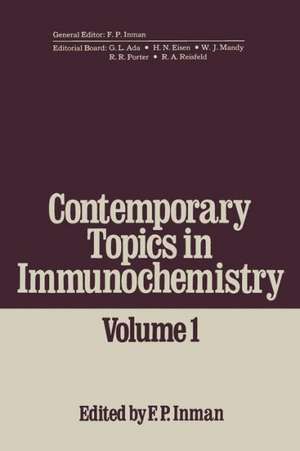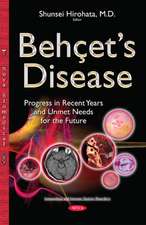Contemporary Topics in Immunochemistry: Volume 1
Autor F. Inmanen Limba Engleză Paperback – 16 noi 2012
Preț: 363.07 lei
Preț vechi: 382.18 lei
-5% Nou
Puncte Express: 545
Preț estimativ în valută:
69.47€ • 72.73$ • 57.48£
69.47€ • 72.73$ • 57.48£
Carte tipărită la comandă
Livrare economică 05-19 aprilie
Preluare comenzi: 021 569.72.76
Specificații
ISBN-13: 9781475713459
ISBN-10: 1475713452
Pagini: 200
Ilustrații: XII, 186 p. 12 illus.
Dimensiuni: 152 x 229 x 11 mm
Greutate: 0.28 kg
Ediția:Softcover reprint of the original 1st ed. 1972
Editura: Springer Us
Colecția Springer
Locul publicării:New York, NY, United States
ISBN-10: 1475713452
Pagini: 200
Ilustrații: XII, 186 p. 12 illus.
Dimensiuni: 152 x 229 x 11 mm
Greutate: 0.28 kg
Ediția:Softcover reprint of the original 1st ed. 1972
Editura: Springer Us
Colecția Springer
Locul publicării:New York, NY, United States
Public țintă
ResearchCuprins
The Relationship Between Antigenic Structure and Immune Specificity.- I. Introduction.- II. Antigens.- III. Discussion.- IV. Concluding Remarks.- References.- Human Histocompatibility Antigens.- I. Introduction.- II. Extraction of Histocompatibility Antigens.- III. Solubilization and Purification of HL-A Antigens.- IV. Biological Evaluation of Soluble HL-A Antigens.- V. Chemical Characterization of HL-A Antigens.- VI. Chemical Nature of HL-A Alloantigens.- VII. Summary.- Acknowledgment.- References.- Bacterial Flagellin as an Antigen and Immunogen.- I. Introduction.- II. Properties of Flagellin from Salmonella Organisms.- III. Degradation and Modification of Flagellin.- IV. In Vivo Immunogenicity of Flagellin and Its Derivatives.- V. In Vivo Localization Patterns of Flagellin and Its Derivatives.- VI. In Vitro Behavior of Flagellin and Its Derivatives.- VII. Antigen as a Regulator of Cell Behavior.- VIII. Discussion and Conclusions.- References.- The Transfer of Immunity with Macrophage RNA.- I. Introduction.- II. The Heightened Immunogenicity of Antigens Associated with Macrophages.- III. RNA-Antigen Complexes.- IV. The Transfer of Cellular Immunity with RNA.- V. Informational RNA.- VI. Conclusions.- Acknowledgment.- References.- Relationship of Events at the Lymphocyte Cell Surface to Gene Expression: Approaches to the Problem.- I. Introduction.- II. General Properties of Continuously Growing Cultured Human Lymphocytes.- III. Control of Synthesis of Membrane-Associated Immunoglobulin.- IV. Molecular Events During the Rest to Proliferation Transition in Lymphocytes.- V. Studies on the “Linkage” Between the Plasma Membrane and Cellular Genes.- VI. Summary and Prospects for the Future.- Acknowledgment.- References.- The Antigen-Binding Sites of Immunoglobulins.- I.Introduction.- II. Size and General Features of the Antibody Combining Site.- III. Structural Studies.- IV. Sequence of the Variable Regions of Heavy and Light Chains.- V. Affinity-Labeling Studies.- VI. Conclusion.- References.- ?D Immunoglobulin.- I. Introduction.- II. Isolation of ?D.- III. Structure of ?D.- IV. Biological Properties of ?D.- V. Prospects.- Acknowledgment.- References.










